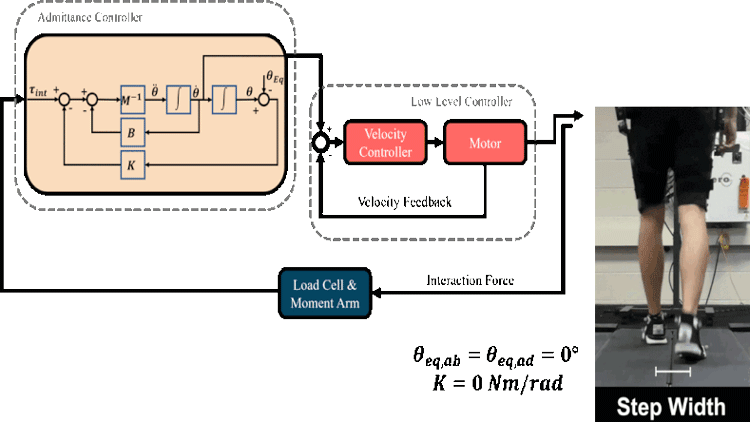Mediolateral balance is found to be adversely affected in older adults, people with lower-limb amputation, poststroke patients, or those with multiple sclerosis either due to compromised sensorimotor integration or decreased muscle strength. This instability in the mediolateral direction increases the risk of falls and serious injuries. Considering the importance of step width in maintaining mediolateral balance, we proposed an active hip exoskeleton capable of facilitating bilateral hip abduction/adduction through admittance control. Through the modification of admittance control parameters during natural walking, we investigated human step width behavior in response to our active hip exoskeleton.
Ten non-disabled individuals walked on a treadmill at their self-selected speed, outfitted with bilateral robotic hip exoskeleton. Two equilibrium positions of admittance control framework were employed to determine the direction of assistance, specifically abduction or adduction. Our investigation focused on assessing the impact of various stiffness values in the admittance control on the participants’ step width, step length, and electromyographic (EMG) activity of the Gluteus Medius.
The alteration of exoskeleton control parameters significantly influenced step width, with noticeable changes, while step length remained unaffected. Participants exhibited an immediate modulation in step width when stiffness shifted from zero to the studied values, becoming significant within four consecutive heel strikes following the stiffness adjustment. Intriguingly, the electromyographic (EMG) activity of the Gluteus Medius showed no significant changes irrespective of the applied stiffness and powered direction. This result suggests that the observed increase in step width primarily resulted from the assistive torque applied by the exoskeleton.
This study is the first to showcase the modulation of step width during walking through a mediolaterally acting robotic hip exoskeleton. Given the significance of step width control in maintaining mediolateral balance, our findings pave the way for future studies to explore proactive interventions for gait balance among individuals with balance deficits.

